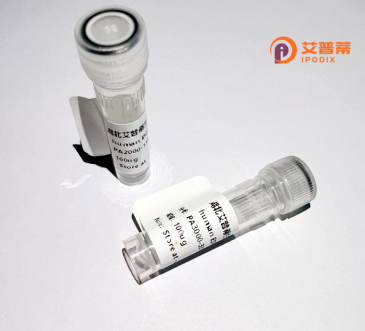
| 纯度 | >90%SDS-PAGE. |
| 种属 | Human |
| 靶点 | NAB2 |
| Uniprot No | Q15742 |
| 内毒素 | < 0.01EU/μg |
| 表达宿主 | E.coli |
| 表达区间 | 1-525 aa |
| 活性数据 | MHRAPSPTAE QPPGGGDSAR RTLQPRLKPS ARAMALPRTL GELQLYRVLQ RANLLSYYET FIQQGGDDVQ QLCEAGEEEF LEIMALVGMA TKPLHVRRLQ KALREWATNP GLFSQPVPAV PVSSIPLFKI SETAGTRKGS MSNGHGSPGE KAGSARSFSP KSPLELGEKL SPLPGGPGAG DPRIWPGRST PESDVGAGGE EEAGSPPFSP PAGGGVPEGT GAGGLAAGGT GGGPDRLEPE MVRMVVESVE RIFRSFPRGD AGEVTSLLKL NKKLARSVGH IFEMDDNDSQ KEEEIRKYSI IYGRFDSKRR EGKQLSLHEL TINEAAAQFC MRDNTLLLRR VELFSLSRQV ARESTYLSSL KGSRLHPEEL GGPPLKKLKQ EVGEQSHPEI QQPPPGPESY VPPYRPSLEE DSASLSGESL DGHLQAVGSC PRLTPPPADL PLALPAHGLW SRHILQQTLM DEGLRLARLV SHDRVGRLSP CVPAKPPLAE FEEGLLDRCP APGPHPALVE GRRSSVKVEA EASRQ |
| 分子量 | 56.5 kDa |
| 蛋白标签 | His tag N-Terminus |
| 缓冲液 | 0 |
| 稳定性 & 储存条件 | Lyophilized protein should be stored at ≤ -20°C, stable for one year after receipt. Reconstituted protein solution can be stored at 2-8°C for 2-7 days. Aliquots of reconstituted samples are stable at ≤ -20°C for 3 months. |
| 复溶 | Always centrifuge tubes before opening.Do not mix by vortex or pipetting. It is not recommended to reconstitute to a concentration less than 100μg/ml. Dissolve the lyophilized protein in distilled water. Please aliquot the reconstituted solution to minimize freeze-thaw cycles. |
以下是关于重组人NAB2蛋白的3篇参考文献摘要,涵盖其功能、结构及疾病关联研究:
---
1. **文献名称**:*NAB2-STAT6 fusion protein reprograms a subset of PRC2-target genes in solitary fibrous tumor*
**作者**:Müller et al.
**摘要**:该研究解析了NAB2与STAT6基因融合形成的重组蛋白(常见于孤立性纤维性肿瘤)的分子机制。通过重组蛋白表达实验,发现该融合蛋白通过劫持染色质修饰复合物PRC2.导致靶基因异常沉默,促进肿瘤发生。
2. **文献名称**:*Structural and functional analysis of the NAB2-STAT6 fusion oncoprotein*
**作者**:Okimoto et al.
**摘要**:研究利用重组NAB2-STAT6融合蛋白进行结构建模和功能分析,揭示了融合后的蛋白获得组成性激活特性,异常激活STAT6下游信号通路,为靶向治疗孤立性纤维性肿瘤提供了理论依据。
3. **文献名称**:*NAB2. a corepressor of NGFI-A (Egr-1), contains an active transcriptional repression domain*
**作者**:Svaren et al.
**摘要**:早期经典研究,通过重组人NAB2蛋白的体外实验,证明其作为转录抑制因子,与EGR1结合并抑制其活性,参与调控细胞生长相关基因的表达。
---
如需更多文献或领域细分,请补充说明研究方向(如结构生物学、肿瘤机制等)。
NGFI-A binding protein 2 (NAB2), a member of the NAB transcriptional coregulator family, is a critical mediator of gene expression regulation, primarily through its interaction with Early Growth Response (EGR) transcription factors, particularly EGR1. This protein functions as a transcriptional repressor by recruiting chromatin-modifying complexes to EGR target genes, modulating cellular processes such as proliferation, differentiation, and apoptosis. The human NAB2 gene is located on chromosome 12q13.3 and encodes a protein containing conserved N-terminal repression domains and C-terminal zinc finger motifs essential for EGR binding.
Recombinant human NAB2 (rhNAB2) is produced via genetic engineering in bacterial, insect, or mammalian expression systems, enabling controlled studies of its structure-function relationships. Researchers utilize rhNAB2 to investigate its role in cancer, fibrosis, and neurological disorders, where dysregulation of the EGR-NAB axis is implicated. Structural analyses (e.g., X-ray crystallography) of rhNAB2 have revealed conformational changes during EGR binding, offering insights into its allosteric regulatory mechanisms. Additionally, rhNAB2 serves as a tool for developing therapeutic strategies targeting EGR-driven pathologies. Its stable recombinant form facilitates high-throughput screening for inhibitors or enhancers of NAB2-EGR interactions, with potential applications in precision medicine and gene therapy.
×